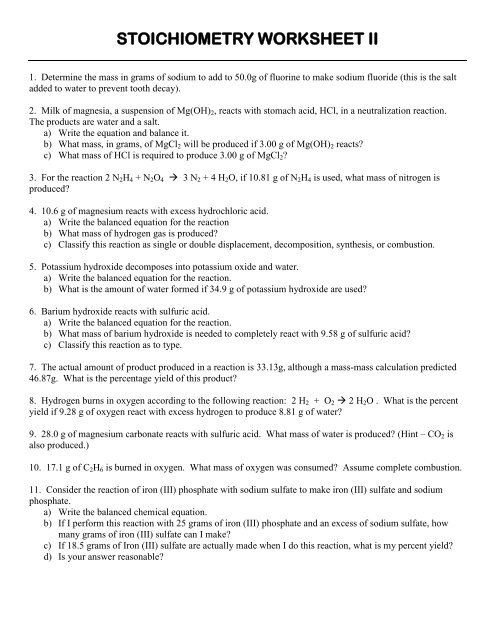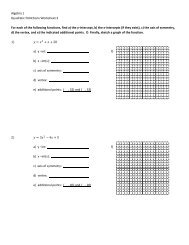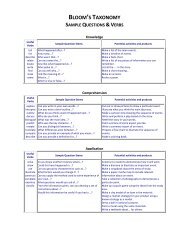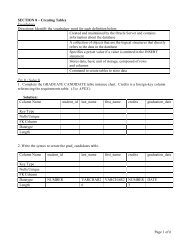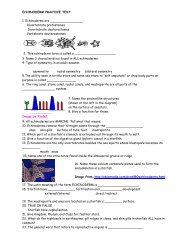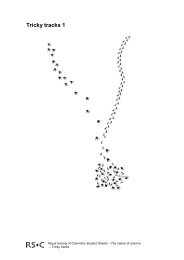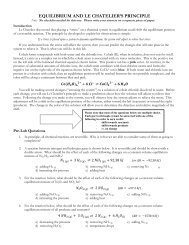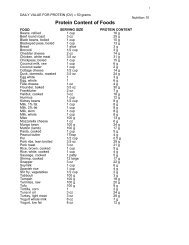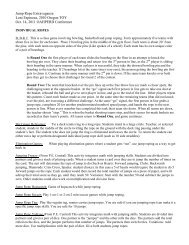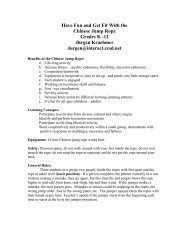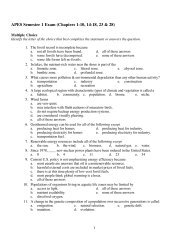You also want an ePaper? Increase the reach of your titles
YUMPU automatically turns print PDFs into web optimized ePapers that Google loves.
<strong>STOICHIOMETRY</strong> <strong>WORKSHEET</strong> <strong>II</strong>1. Determine the mass in grams of sodium to add to 50.0g of fluorine to make sodium fluoride (this is the saltadded to water to prevent tooth decay).2. Milk of magnesia, a suspension of Mg(OH) 2 , reacts with stomach acid, HCl, in a neutralization reaction.The products are water and a salt.a) Write the equation and balance it.b) What mass, in grams, of MgCl 2 will be produced if 3.00 g of Mg(OH) 2 reacts?c) What mass of HCl is required to produce 3.00 g of MgCl 2 ?3. For the reaction 2 N 2 H 4 + N 2 O 4 3 N 2 + 4 H 2 O, if 10.81 g of N 2 H 4 is used, what mass of nitrogen isproduced?4. 10.6 g of magnesium reacts with excess hydrochloric acid.a) Write the balanced equation for the reactionb) What mass of hydrogen gas is produced?c) Classify this reaction as single or double displacement, decomposition, synthesis, or combustion.5. Potassium hydroxide decomposes into potassium oxide and water.a) Write the balanced equation for the reaction.b) What is the amount of water formed if 34.9 g of potassium hydroxide are used?6. Barium hydroxide reacts with sulfuric acid.a) Write the balanced equation for the reaction.b) What mass of barium hydroxide is needed to completely react with 9.58 g of sulfuric acid?c) Classify this reaction as to type.7. The actual amount of product produced in a reaction is 33.13g, although a mass-mass calculation predicted46.87g. What is the percentage yield of this product?8. Hydrogen burns in oxygen according to the following reaction: 2 H 2 + O 2 2 H 2 O . What is the percentyield if 9.28 g of oxygen react with excess hydrogen to produce 8.81 g of water?9. 28.0 g of magnesium carbonate reacts with sulfuric acid. What mass of water is produced? (Hint – CO 2 isalso produced.)10. 17.1 g of C 2 H 6 is burned in oxygen. What mass of oxygen was consumed? Assume complete combustion.11. Consider the reaction of iron (<strong>II</strong>I) phosphate with sodium sulfate to make iron (<strong>II</strong>I) sulfate and sodiumphosphate.a) Write the balanced chemical equation.b) If I perform this reaction with 25 grams of iron (<strong>II</strong>I) phosphate and an excess of sodium sulfate, howmany grams of iron (<strong>II</strong>I) sulfate can I make?c) If 18.5 grams of Iron (<strong>II</strong>I) sulfate are actually made when I do this reaction, what is my percent yield?d) Is your answer reasonable?
Examples from the Pulp and Paper Industry:12. In a Kraft chemical recovery boiler, sodium sulfate and carbon (C) are combined to produce sodium sulfideand carbon dioxide.a) If 500.0 g of sodium sulfate and 900.0 g of carbon are available, how much sodium sulfide would beproduced?b) What is the limiting reagent?c) If only 238 g of sodium sulfide are produced, what is the percent yield?13. In the causticizing reaction that occurs in a modern pulp and paper mill, sodium carbonate is combined withcalcium hydroxide to produce sodium hydroxide and calcium carbonate. If 95.0 g of calcium hydroxide isadded to 106.0 g of sodium carbonate,a) How much sodium hydroxide is produced?b) What limits the reaction?c) If only 45.0 g of sodium hydroxide is produced, what is the percent yield?14. In a piece of equipment called the Slaker, the slaking reaction occurs. In this reaction, 243 moles ofcalcium oxide (also known as lime) is combined with 305 g of water to produce calcium hydroxide.a) How much calcium hydroxide is produced?b) What limits the reaction?c) How much additional water is required to react all of the calcium oxide?ANSWERS:1. 60.5 g Na2a. Mg(OH) 2 + 2HCl → MgCl 2 + 2H 2 O2b. 4.90 g MgCl 22c. 2.30 g HCl3. 14.18 g N 24a. Mg + 2HCl → MgCl2 + H 24b. .879 g H 24c. single replacement5a. 2KOH → K 2 O + H 2 O5b. 5.60 g H 2 O6a. Ba(OH) 2 + H 2 SO 4 → BaSO 4 + 2H 2 O6b. 16.7 g Ba(OH) 26c. double replacement7. 70.68%8. 84.3%9. 5.98 g H 2 O10. 63.7 g O 211a. 2FePO 4 + 3Na 2 SO 4 → Fe 2 (SO 4 ) 3 + 2Na 3 PO 411b. 33.1 g Fe 2 (SO 4 ) 311c. 55.9%11d. Yes – the percent yield should not be greater than 100%.12a. Na 2 SO 4 + 2C → Na 2 S + 2CO 2 ; 274.7 g Na 2 S12b. sodium sulfate limits the reaction12c. 86.6%13a. Na 2 CO 3 + Ca(OH) 2 → 2NaOH + CaCO 3 ; 80.0 g NaOH13b. sodium carbonate limits the reaction13c. 56.2%14a. CaO + H 2 O → Ca(OH) 2 ; 1250 g Ca(OH) 2 produced14b. Water limits the reaction14c. 4070 g H 2 O


